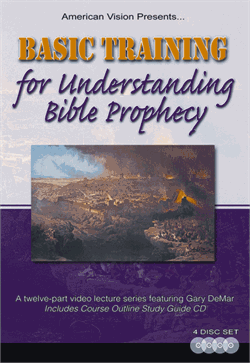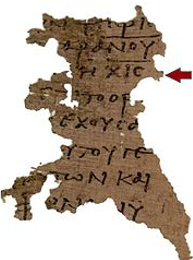Does the number 666 refer to someone in John’s day? If so, who could it be? Revelation implies that there was a king who was alive when John saw and wrote down what was revealed to him:
“Here is the mind which has wisdom.[1] The seven heads are seven mountains on which the woman sits,[2] and they are seven kings; five have fallen, one is, the other has not yet come; and when he comes, he must remain a little while. The beast which was and is not, is himself also an eighth and is one of the seven, and he goes to destruction” (Rev. 17:9-11).
The “one is” informed the first readers that the sixth “head/king” was ruling in their day. Beginning with Julius Caesar, Nero would be the “sixth king.” Richard Bauckham writes:
The solution to the riddle of 666 which has been most widely accepted since it was first suggested in 1831 is that 666 is the sum of the letters of Nero Caesar written in Hebrew characters as נרון קסר (נ = 50 + ר = 200 + ו = 6 + ן = 50 + ק = 100 + ס = 60 + ר = 200). Few of the many other solutions by gematria[3] which have been proposed offer a name, which the phrase ‘the number of his name’ (Rev. 13:17; 15:2) requires, and of those few which do this seems eminently the most preferable.[4]
The first readers of Revelation were told, “Here is wisdom. Let him who has understanding calculate the number of the beast…” (Rev. 13:17). When trying to match “six hundred and sixty-six” with a particular name, we need a relevant candidate from the time period when Revelation was written, otherwise why the statement about “wisdom” and “knowledge”? This requirement had to apply to the first readers.

Basic Training for Understanding Bible Prophecy
In this authoritative 12-part MP4 series, Gary DeMar clears the haze regarding end-times themes by explaining in clear language the interpretation of the time texts, The Olivet Discourse, Daniel's Seventy Weeks, The Book of Revelation, and more! Includes BONUS: 120-page study guide with outlines of each lecture, study questions, supplemental readings, and 15 additional articles on eschatology.
Buy NowSince Revelation was written to and for a first-century audience, we should expect the first-century readers to be able to calculate the number with relative ease and understand the result.
When Nero Caesar’s name is transliterated into Hebrew, which a first-century Jew would probably have done like the way we today would first try English, he would have gotten Neron Kesar or simply nrwn qsrsince Hebrew is an alphabet of only consonants. “It has been documented by archaeological finds that a first century Hebrew spelling of Nero’s name provides us with precisely the value of 666. Jastrow’s lexicon of the Talmud contains this very spelling.”[5] Coins were struck with the spelling NEPΩN KAIΣAP ΣEBAΣTOΣ “Neron Caesar Augustus.” (See image above. Obverse: Bust of Nero, Greek inscription: [NEPΩN KAIΣAP] ΣEBAΣTOΣ “[Neron Caesar] Augustus.” Reverse: Greek inscription in wreath: EΠI / BACIΛE / AΓPIΠΠ / NEPΩ / NIE “In the days of King Agrippa, of the people of Neronias, (Panias).”)
When we take the letters of Nero’s name and spell them in Hebrew, we get the following numeric values: n = 50, r = 200, w = 6, n = 50, q = 100, s = 60, r = 200 = 666.
Every Jewish reader, of course, saw that the Beast was a symbol of Nero. And both Jews and Christians regarded Nero as also having close affinities with the serpent or dragon . . . The Apostle writing as a Hebrew, was evidently thinking as a Hebrew . . . Accordingly, the Jewish Christian would have tried the name as he thought of the name—that is in Hebrew letters. And the moment that he did this the secret stood revealed. No Jew ever thought of Nero except as “Neron Kesar.”[6]
A textual variant in some New Testament manuscripts has the number of the Beast as 616 based on the reading of nrw qsr — Nero Caesar — instead of “the Greek form Nerwn, . . . so that the final ן is omitted from נרון , the numerical value becomes 616.”[7]

Even some non-preterists see the relationship between Nero and the numerical designation of the number 666. For example, James M. Hamilton, Jr., writes, “So Nero was a wicked tyrant who persecuted Christians and was worshiped as a god and had expectations that he would return from the dead the way only Jesus had really done. I think that John is now seeing in his vision the typological fulfillment of the historical Nero in this final Antichrist who is a seven-headed, ten-horned beast who has a false prophet who enforces the worship of the beast with the threat of death.”[8]
While I believe James Hamilton is correct in identifying Nero as the sea beast of Revelation 13, I think he is wrong is projecting a type of dual fulfillment in a distant antichrist figure. John tells us that an antichrist is someone who does “not acknowledge Jesus Christ as coming in the flesh” (2 John 7; see 1 John 2:22; 4:3). This is most likely a religious character not a political one. In addition, John earlier told the recipients of his first letter that it was “the last hour; and just as you heard that antichrist is coming, even now many antichrists have appeared; from this we know that it is the last hour” (1 John 2:18). Later in the same epistle, John writes, “and every spirit that does not confess Jesus is not from God; this is the spirit of the antichrist, of which you have heard that it is coming, and now it is already in the world” (1 John 4:3). Nowhere does John argue for a distant tribulation period where a super antichrist will appear.
Jews familiar with the Old Testament had seen the number six hundred and sixty-six before (not 6-6-6 but 600+60+6 = 666). Prior to Solomon’s slide into apostasy, a description of his reign is given. One of the things said about him is that “the weight of gold which came in to Solomon in one year was 666 talents of gold” (1 Kings 10:14). From the number of shields (300) to the price of a horse imported from Egypt (150 shekels), we find round numbers, except when the number of gold talents is mentioned.
From the point where we are told that 666 talents of gold came into Solomon’s possession in one year, we read of Solomon’s apostasy. First, Solomon violates the law regarding the accumulation of horses, chariots, wives, and gold (1 Kings 10:26; see Deut. 17:16-17).
The law of Deuteronomy 17 forbad the king to multiply gold, women, and horses, but here we see Solomon do all three. In Revelation, the religious rulers of the “land” are called kings, the “kings of the land.” The apostasy of the High Priest, and of the religious leaders of Israel, is thus linked to Solomon’s sin. As Solomon lost his kingdom when the northern tribes rebelled after his death, so the Land Beast will lose his kingdom permanently when Jerusalem is destroyed.[9]
Second, Solomon sells himself to foreign interests by marrying foreign women to create political alliances (1 Kings 11:1-2). It is here that we see a parallel with Revelation 13. In their rejection of Jesus as the promised Messiah (“He came to His own, and those who were His own did not receive Him”: John 1:11), the Jews committed spiritual adultery with the nations (Roman Empire of nations) in the way that Solomon committed physical/spiritual adultery with the nations surrounding him:
Now Solomon loved many foreign women along with the daughter of Pharaoh: Moabite, Ammonite, Edomite, Sidonian, and Hittite women, from the nations concerning which the LORD had said to the sons of Israel, “You shall not associate with them, neither shall they associate with you, for they will surely turn your heart away after their gods.” Solomon held fast to these in love. And he had seven hundred wives, princesses, and three hundred concubines, and his wives turned his heart away (1 Kings 11:1-3).
James Jordan sums up the connection between Solomon and the apostate character of the Church’s enemy in Revelation 13:
The number of the name (character) of the Sea Beast, then, means “apostate Solomon; apostate Jew.” It is Solomon, not free under Yahweh’s rule, but enslaved to Gentiles through illicit trade, the idol worshipping wiles of his women, and his lust for gold.[10]
It’s possible, therefore, that 666 refers to both Nero and Solomon since the Sea Beast (Roman Empire under Nero) and the Land Beast (Israel as a “synagogue of Satan”: Rev. 2:9; 3:9) cooperate in their desire to see the new covenant people of God destroyed. Those Jews who rejected Jesus (the greater David: Acts 2:25-36) embraced the apostasy of Solomon.

The Beast of Revelation
This thoroughly researched work unpacks ancient mysteries, helping readers grapple with some of their deepest questions. Any Christian frightened about the future will regain hope by reading this book because it answers questions people are yearning to understand.
Buy NowMarrying foreign wives was like what the Jews did when they cried out at Jesus’ trial before Pontius Pilate, the civil representative of Rome, “We have no king but Caesar” (John 19:15). They aligned themselves with Rome against Jesus. This made them true antichrists. They chose the illegitimate Barabbas (“son [bar] of a father [abba]”) rather than the true son, Jesus (Son of the Father).
[1]Compare with Revelation 13:18.
[2]This is most likely a reference to Rome, as in the “seven hills of Rome.” The woman sitting on the seven hills is Israel (See Ezek. 16; 5:9, compare with Matt. 24:21).
[3]A system of assigning numerical value to a word or phrase.
[4]Richard Bauckham, The Climax of Prophecy: Studies on the Book of Revelation (Edinburgh: T&T Clark, 1993), 387.
[5]Kenneth L. Gentry, The Beast of Revelation, chap. 3. Also see R. H. Charles, A Critical and Exegetical Commentary on the Revelation of St. John, 2 vols. (New York: Charles Scribner’s Sons, 1920), 1:367.
[6]Frederic W. Farrar, The Early Days of Christianity (New York: E. P. Dutton, 1882), 471.
[7]Bauckham, The Climax of Prophecy, 387. Also see James Tabor, “Why 2K?: The Biblical roots of Millennialism,” Bible Review (December 1999): http://bit.ly/WtlK30
[8]Hamilton, Revelation, 275.
[9]James B. Jordan, A Brief Reader’s Guide to Revelation (Niceville, FL: Transfiguration Press, 1999), 36.
[10]James B. Jordan, “The Beasts of Revelation (4),” Studies in the Revelation (April 1996), 2.

